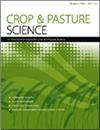Phenotypic, genotypic and nutritional divergence in cowpea and implications for drought tolerance breeding: a review
IF 1.9
4区 农林科学
Q2 AGRICULTURE, MULTIDISCIPLINARY
引用次数: 0
Abstract
ABSTRACT Genetic diversity is crucial for crop improvement in any breeding program. Cowpea is an important indigenous grain vegetable legume crop. The crop has a significant potential to improve food and nutritional security in sub-Saharan Africa (SSA), and family income for resource poor famers. Cowpea is a source of proteins, vitamins (folate, thiamine and vitamin C), minerals (Fe, Zn, Mn and Ca) and amino acids such as lysine and tryptophan, hence, has a high potential for combating nutrient deficiencies. The SSA countries, including South Africa, have been experiencing many dry seasons, which have negatively affected agricultural production and productivity. Cowpea has a long taproot with the ability to grow in arid and semi-arid regions; however, lasting exposure to severe droughts will result in significant yield and grain quality reduction. There has been limited progress in drought tolerance research in cowpea due to the complexity of this trait, as it involves numerous genes, which in turn are affected by environmental conditions. It is therefore important to review research done on the nutritional, phenotypic and genotypic diversity of cowpea and the importance of diversity when breeding for complex quantitative traits such as drought tolerance and yield. The review will also outline the important omics tools used for drought tolerance breeding, cultivar development and as reference for future cowpea breeding.豇豆的表型、基因型和营养差异及其对耐旱育种的启示
本文章由计算机程序翻译,如有差异,请以英文原文为准。
求助全文
约1分钟内获得全文
求助全文
来源期刊

Crop & Pasture Science
AGRICULTURE, MULTIDISCIPLINARY-
CiteScore
4.20
自引率
15.80%
发文量
111
审稿时长
3 months
期刊介绍:
Crop and Pasture Science (formerly known as Australian Journal of Agricultural Research) is an international journal publishing outcomes of strategic research in crop and pasture sciences and the sustainability of farming systems. The primary focus is broad-scale cereals, grain legumes, oilseeds and pastures. Articles are encouraged that advance understanding in plant-based agricultural systems through the use of well-defined and original aims designed to test a hypothesis, innovative and rigorous experimental design, and strong interpretation. The journal embraces experimental approaches from molecular level to whole systems, and the research must present novel findings and progress the science of agriculture.
Crop and Pasture Science is read by agricultural scientists and plant biologists, industry, administrators, policy-makers, and others with an interest in the challenges and opportunities facing world agricultural production.
Crop and Pasture Science is published with the endorsement of the Commonwealth Scientific and Industrial Research Organisation (CSIRO) and the Australian Academy of Science.
 求助内容:
求助内容: 应助结果提醒方式:
应助结果提醒方式:


